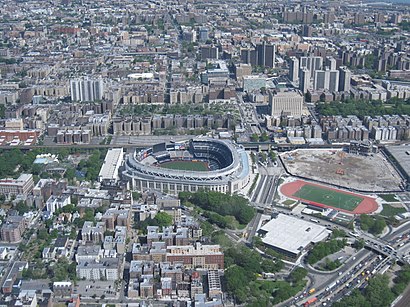See Bronx on the map
Directions to Bronx with public transportation
The following transit lines have routes that pass near Bronx
Bus:
Train:
Subway:
How to get to Bronx by Bus?
Click on the Bus route to see step by step directions with maps, line arrival times and updated time schedules.
How to get to Bronx by Train?
Click on the Train route to see step by step directions with maps, line arrival times and updated time schedules.
How to get to Bronx by Subway?
Click on the Subway route to see step by step directions with maps, line arrival times and updated time schedules.
Bus stations near Bronx
- E Tremont Av/Devoe Av,1 min walk,
- Devoe Av/Wyatt Av,2 min walk,
- E Tremont Av/E 177 St,2 min walk,
- E 180 St/Boston Rd,6 min walk,
Subway stations near Bronx
- West Farms Sq - E Tremont Av [2,5],4 min walk,
- Morrison Av- Sound View [6x,6],21 min walk,
Bus lines to Bronx
- BX21,Mott Haven 136 St,
- BX36,Washington Hts Via Tremont Av,
- Q44-SBS,Select Bus Jamaica Via Main St,
- BX9,West Farms,
- BX40,River Pk Twr Via E Trmnt Av Via 180-Burn,
- BX42,River Pk Twr Via E Tremont Av Via 180-Bu,
What are the closest stations to Bronx?
The closest stations to Bronx are:
- E Tremont Av/Devoe Av is 46 yards away, 1 min walk.
- Devoe Av/Wyatt Av is 93 yards away, 2 min walk.
- E Tremont Av/E 177 St is 135 yards away, 2 min walk.
- West Farms Sq - E Tremont Av [2,5] is 264 yards away, 4 min walk.
- E 180 St/Boston Rd is 463 yards away, 6 min walk.
- Morrison Av- Sound View [6x,6] is 1703 yards away, 21 min walk.
Which Bus lines stop near Bronx?
These Bus lines stop near Bronx: BX21, BXM10, Q44-SBS
Which Train lines stop near Bronx?
These Train lines stop near Bronx: HARLEM
Which Subway lines stop near Bronx?
These Subway lines stop near Bronx: 2, 5
What’s the nearest subway station to Bronx?
The nearest subway station to Bronx is West Farms Sq - E Tremont Av [2,5]. It’s a 4 min walk away.
What’s the nearest bus stop to Bronx?
The nearest bus stop to Bronx is E Tremont Av/Devoe Av. It’s a 1 min walk away.

Public Transportation to Bronx
Wondering how to get to Bronx, United States? Moovit helps you find the best way to get to Bronx with step-by-step directions from the nearest public transit station.
Moovit provides free maps and live directions to help you navigate through your city. View schedules, routes, timetables, and find out how long does it take to get to Bronx in real time.
Looking for the nearest stop or station to Bronx? Check out this list of stops closest to your destination: E Tremont Av/Devoe Av; Devoe Av/Wyatt Av; E Tremont Av/E 177 St; West Farms Sq - E Tremont Av [2,5]; E 180 St/Boston Rd; Morrison Av- Sound View [6x,6].
Bus:Train:Subway:
Want to see if there’s another route that gets you there at an earlier time? Moovit helps you find alternative routes or times. Get directions from and directions to Bronx easily from the Moovit App or Website.
We make riding to Bronx easy, which is why over 1.5 million users, including users in Bronx, trust Moovit as the best app for public transit. You don’t need to download an individual bus app or train app, Moovit is your all-in-one transit app that helps you find the best bus time or train time available.
For information on prices of Subway, Bus and Train, costs and ride fares to Bronx, please check the Moovit app.
Use the app to navigate to popular places including to the airport, hospital, stadium, grocery store, mall, coffee shop, school, college, and university.
Bronx Address: Bronx, NY 10460, USA street in Bronx

Attractions near Bronx
- E Tremont Ave Devoe
- E Tremont Dev
- 362 Devoe Ave
- 179th / Devoe
- E Tremont Ave
- Tremont Ave & E 177 St
- E 177 E Tre
- E Tremont Ave and E 177th St
- 177 St Tremont
- E E 177 E E Tre
- Dunkin'
- Devoe Ave (wyatt st devoe av)
- Devoe Ave / Wya
- WESTERN UNION
- Jimbo's Hamburger Palace (Jimbos Hamburger Palace)
- Inkstudio (Ink Studio)
- E 177th St (177th wyatt)
- 177th St & Wyatt St
- 177th Wyatt St
- MTA - Q44 Bus Stop
How to get to popular attractions in Bronx with public transit
- Café Habana, Manhattan
- Hotel Chantelle, Manhattan
- LIRR - Babylon Station, Babylon, Ny
- SoHo, Manhattan
- Ulysses Folk House, Manhattan
- Avenue, Manhattan
- The Meatball Shop
- Dos Toros Taquería, Manhattan
- I-80 (Interstate 80), Paterson, Nj
- Bill's Bar & Burger, Manhattan
- Nassau Community College, East Garden City, Ny
- NJT - New Brunswick Station (NEC), New Brunswick, Nj
- Time Life, Manhattan
- Gramercy Tavern, Manhattan
- The Standard Grill, Manhattan
- MTA Subway - Fulton St (A / C/J / Z/2 / 3/4 / 5), Manhattan
- Jing Fong Restaurant 金豐大酒樓, Manhattan
- Ritz Bar & Lounge, Manhattan
- MTA Subway - 30th Ave (N/W), Queens
- The Grey Dog, Manhattan